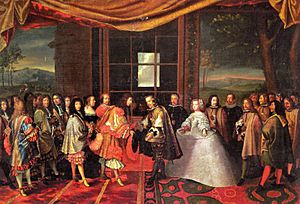Treaty of the Pyrenees facts for kids

Louis XIV and Philip IV of Spain at the Meeting on the Isle of Pheasants, June 1660
|
|
| Context | Spain and France end the 1635–1659 war; Spain cedes Artois and Northern Catalonia; Louis marries Maria Theresa of Spain |
|---|---|
| Signed | 7 November 1659 |
| Location | Pheasant Island |
| Negotiators | |
| Signatories | |
| Parties | |
The Treaty of the Pyrenees was an important agreement signed on November 7, 1659. It officially ended a long war between France and Spain that had lasted from 1635 to 1659.
The talks happened on Pheasant Island. This island is in the middle of the Bidasoa River, right on the border between the two countries. It has been shared by France and Spain ever since. The treaty was signed by Louis XIV of France and Philip IV of Spain. Their main advisors, Cardinal Mazarin for France and Don Luis Méndez de Haro for Spain, also signed it.
Contents
Why the Treaty Was Needed
France joined the Thirty Years' War after Spain won battles in the Dutch Revolt in the 1620s. Spain also won a big battle against Sweden in 1634. By 1640, France started getting involved in Spanish politics. They helped a revolt in Catalonia, a region in Spain. In return, Spain helped a revolt in France called the Fronde in 1648.
During peace talks in 1648, France gained land called Sundgau. This land blocked Spain's access to the Netherlands from Austria. This led to an open war between France and Spain.
After 23 years of fighting, an alliance of England and France won a battle called the Battle of the Dunes in June 1658. However, the war slowed down the next year when France failed to take Milan. So, peace was finally made with the Treaty of the Pyrenees in November 1659.
What the Treaty Decided
France gained several new territories. These included Roussillon (which has Perpignan) and the northern part of Cerdanya. France also got Montmédy and other areas in Luxembourg. In Flanders, France gained Artois and towns like Arras, Béthune, Gravelines, and Thionville.
The treaty set a new border between France and Spain along the Pyrenees mountains. However, the treaty said only "villages" north of the Pyrenees would become part of France. Because Llívia was a historic town, not just a village, it was not included. This made Llívia a Spanish area completely surrounded by France. This border was not fully settled until the Treaty of Bayonne in 1856. In the western Pyrenees, a clear border was drawn. Decisions were made about areas in the Basque region, like Baztan, Aldude, and Valcarlos.
Spain had to accept all the land France had gained in the Peace of Westphalia. In exchange for losing land, the French king promised to stop helping Portugal. He also gave up his claim to the county of Barcelona. France had claimed Barcelona since the Catalan Revolt.
France had supported the Portuguese revolt in 1640. After the Catalan Revolt, France controlled the Principality of Catalonia from 1641. This was after a combined Catalan and French army beat the Spanish army at the Battle of Montjuïc. Spain later won back most of Catalonia in 1652. But France kept the Catalan land north of the Pyrenees.
The treaty also arranged a marriage between Louis XIV of France and Maria Theresa of Spain. She was the daughter of Philip IV of Spain. Maria Theresa had to give up her right to the Spanish throne. In return, she was supposed to receive a large sum of money as her dowry. This money was never paid. This later led to a war called the War of Devolution in 1668. In June 1660, the two kings and their advisors met on Pheasant Island. After this meeting, Princess Maria Theresa went to France.
England also received Dunkirk as part of the agreement. However, England later sold Dunkirk to France in 1662.
What Happened Next

The Treaty of the Pyrenees was a major success for Cardinal Mazarin, France's chief minister. Along with the Peace of Westphalia, this treaty gave Louis XIV of France great stability and a strong position in Europe. Spain's power was weakened. The unpaid dowry was also important for the French king's plans.
By 1660, most of Europe was peaceful. The French royal family, the Bourbons, had ended the long dominance of the Habsburgs. In the Pyrenees, the treaty created border customs. This made it harder for people and goods to move freely across the border. The treaty also finally settled a long dispute over the Kingdom of Navarre. However, a disagreement about the Aldudes area continued into the 1700s.
French Land Gains
The treaty meant France gained land on both its northern and southern borders.
- In the north, France gained an area called French Flanders.
- In the south:
- On the east: The northern part of Principality of Catalonia became part of France. This included Roussillon, Conflent, Vallespir, Capcir, and French Cerdagne. This area is now known as "Northern Catalonia".
- On the west: Both sides agreed to send a team to draw a border in disputed lands along the Basque Pyrenees. This included areas like Sareta—Zugarramurdi, Ainhoa, and the Spanish area of Valcarlos.
|
See also
 In Spanish: Tratado de los Pirineos para niños
In Spanish: Tratado de los Pirineos para niños



